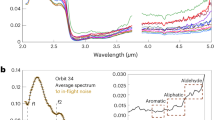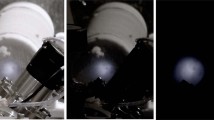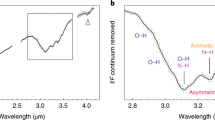Abstract
THE 3.1 -µm absorption band of water frost has been tentatively identified in spectra of the Galilean satellites Ganymede and Callisto. This is the first positive evidence for water frost on the surface of Callisto. The depth of this absorption band on both satellites is about twice as deep as is inferred from the depths of the water frost bands at 1.5 and 2.0 µm. Previous high resolution spectral studies (Δλ/λ∼0.02) of the Galiliean satellites in the 1.0–2.5 μm region have identified water frost on the surfaces of Europa (J II) and Ganymede (J III) from the presence of characteristic water frost absorption bands at 1.5 and 2.0 µm1–3. All studies failed to positively identify water frost on either Io (J I) or Callisto (J IV) but were used to set an upper limit of 5–25% (surficial coverage) for the amount of water frost on Callisto1. The spectrum of water frost also has a characteristic band at about 3.1 µm which is stronger than the ones at shorter wavelengths3–5. Previous studies have shown a decreased reflectance between 3 and 4 µm for Callisto, but water frost could not be positively identified because of low spectral resolution6,7 and poor signal-to-noise and the problem of using the Moon as a standard because of the onset of lunar thermal emission beyond 2.5 µm (refs 1,2).
This is a preview of subscription content, access via your institution
Access options
Subscribe to this journal
Receive 51 print issues and online access
$199.00 per year
only $3.90 per issue
Buy this article
- Purchase on Springer Link
- Instant access to full article PDF
Prices may be subject to local taxes which are calculated during checkout
Similar content being viewed by others
References
Pilcher, C. B., Ridgeway, S. T. & McCord, T. B. Science 178, 1087–1089 (1972).
Fink U., Dekkers, N. H. & Larson, H. P. Astrophys. J. 179, L 155–159 (1973).
Kieffer H. H. & Smythe, W. D. Icarus 21, 506–512 (1974).
Smythe, W. D. Icarus 24, 421–427 (1975).
Irvine, W. M. & Pollack, J. B. Icarus 8, 324–360 (1968).
Gillett F. C., Merrill, K. M. & Stein, W. A. Astrophys. Lett. 6, 247–249 (1970).
Hansen, O. L. Icarus 26, 24–29 (1975).
Low, F. J. & Rieke, G. H. Meth. Exp. Phys. 12A, 415–462 (1974).
Johnson H. L., Mitchell, P. I., Iriarte, B. & Wisniewski, W. Z. Commun. lunar Planet. Lab. 63, 99–110 (1966).
Labs, D. & Neckel, H. Solar Phys. 15, 79–87 (1970).
Johnson, T. V. & Fanale, F. P. J. geophys. Res. 78, 8507–8518 (1973).
Consolmagno, G. J. & Lewis, J. S. Jupiter studies of the Interior, Atmosphere, Magnetosphere and Satellites, 1035–1051 (1976).
Pollack, J. B., Witteborn, P., Erickson, E., Strecker, D., & Baldwin, H. presented at 8th Annual Planetary Geology Principal Investigator's Symposium, St. Louis, Missouri (1977).
Anderson, D. M. & Hoekstra, P. Am. Proc. Soil Soc. 31, 498–504 (1965).
Lebofsky, L. A. presented at 8th A. Planet. Geol. Principal Investigator's Symp., St Louis, Missouri (1977).
Nash, D. B. & Fanale, F. P. Icarus 31, 40–80 (1977).
Author information
Authors and Affiliations
Rights and permissions
About this article
Cite this article
LEBOFSKY, L. Identification of water frost on Callisto. Nature 269, 785–787 (1977). https://doi.org/10.1038/269785a0
Received:
Accepted:
Issue Date:
DOI: https://doi.org/10.1038/269785a0
Comments
By submitting a comment you agree to abide by our Terms and Community Guidelines. If you find something abusive or that does not comply with our terms or guidelines please flag it as inappropriate.



